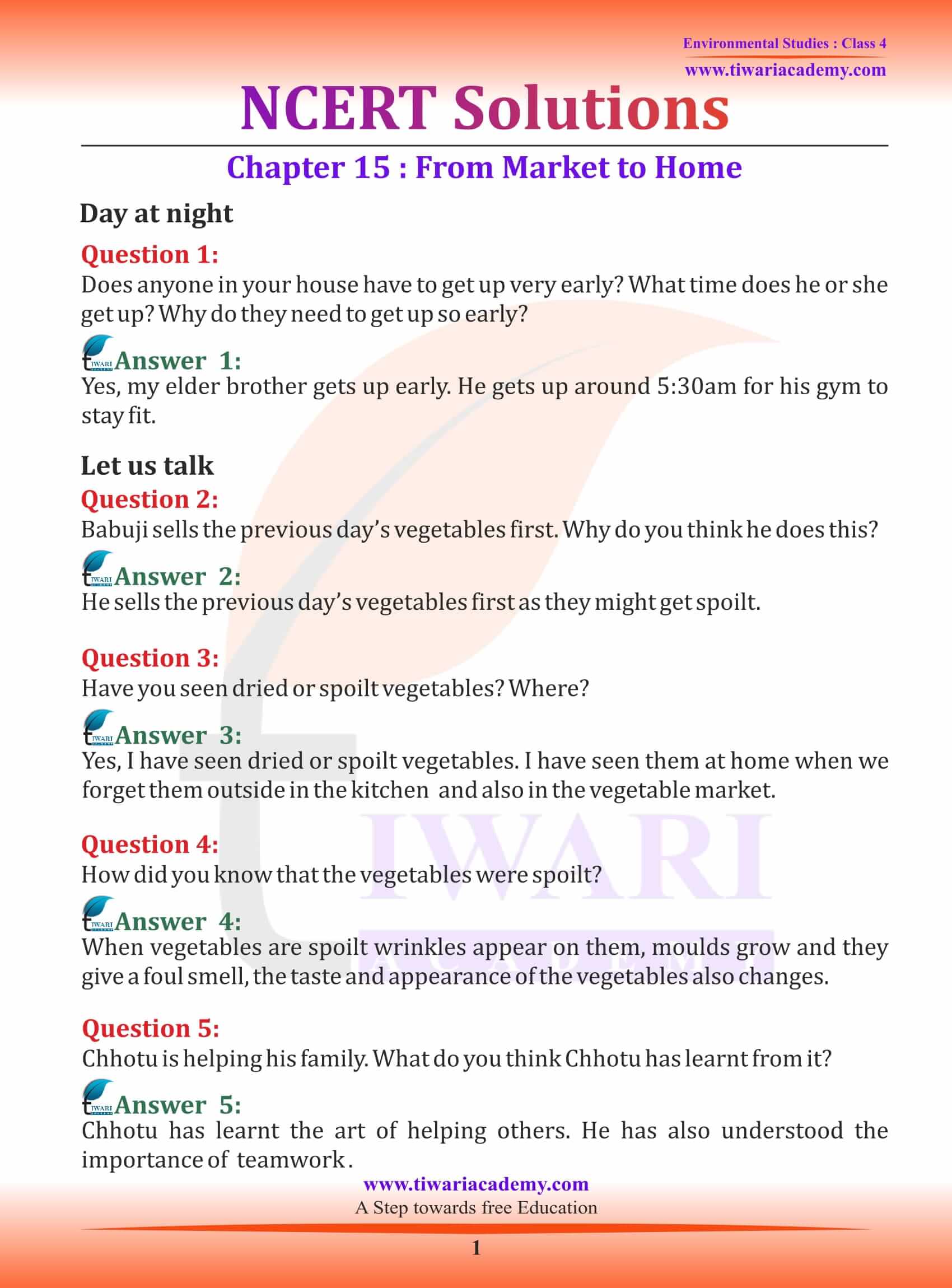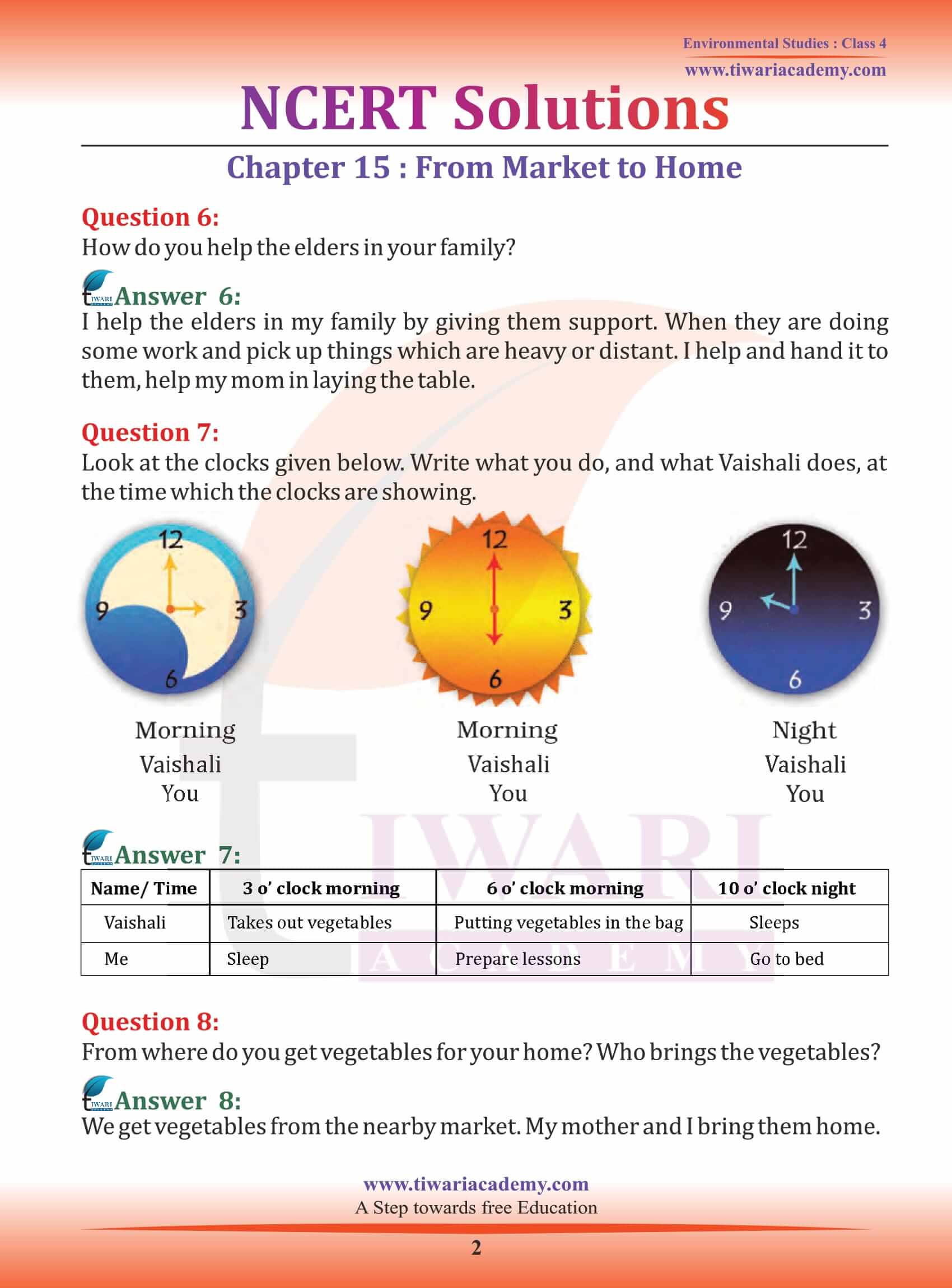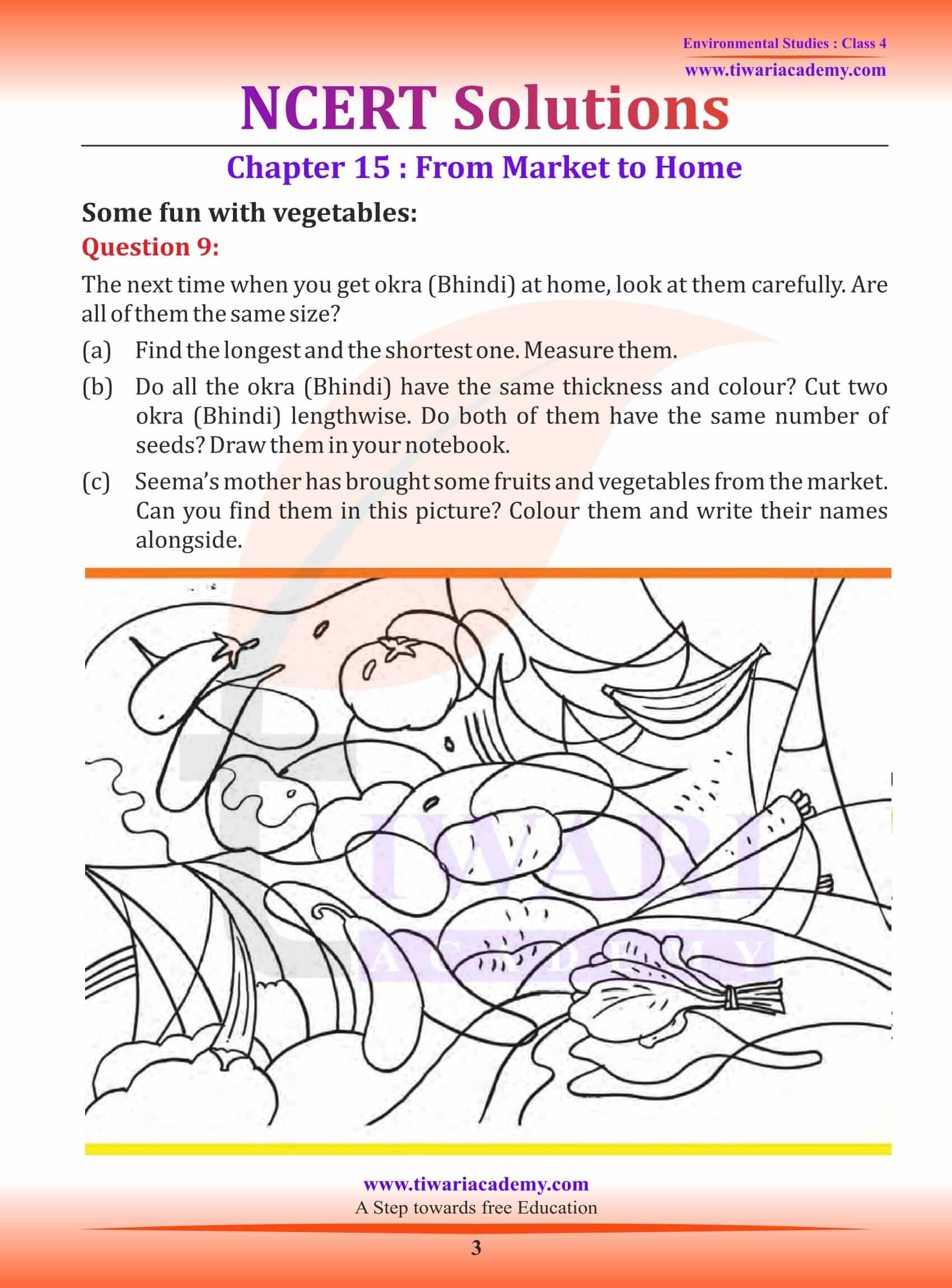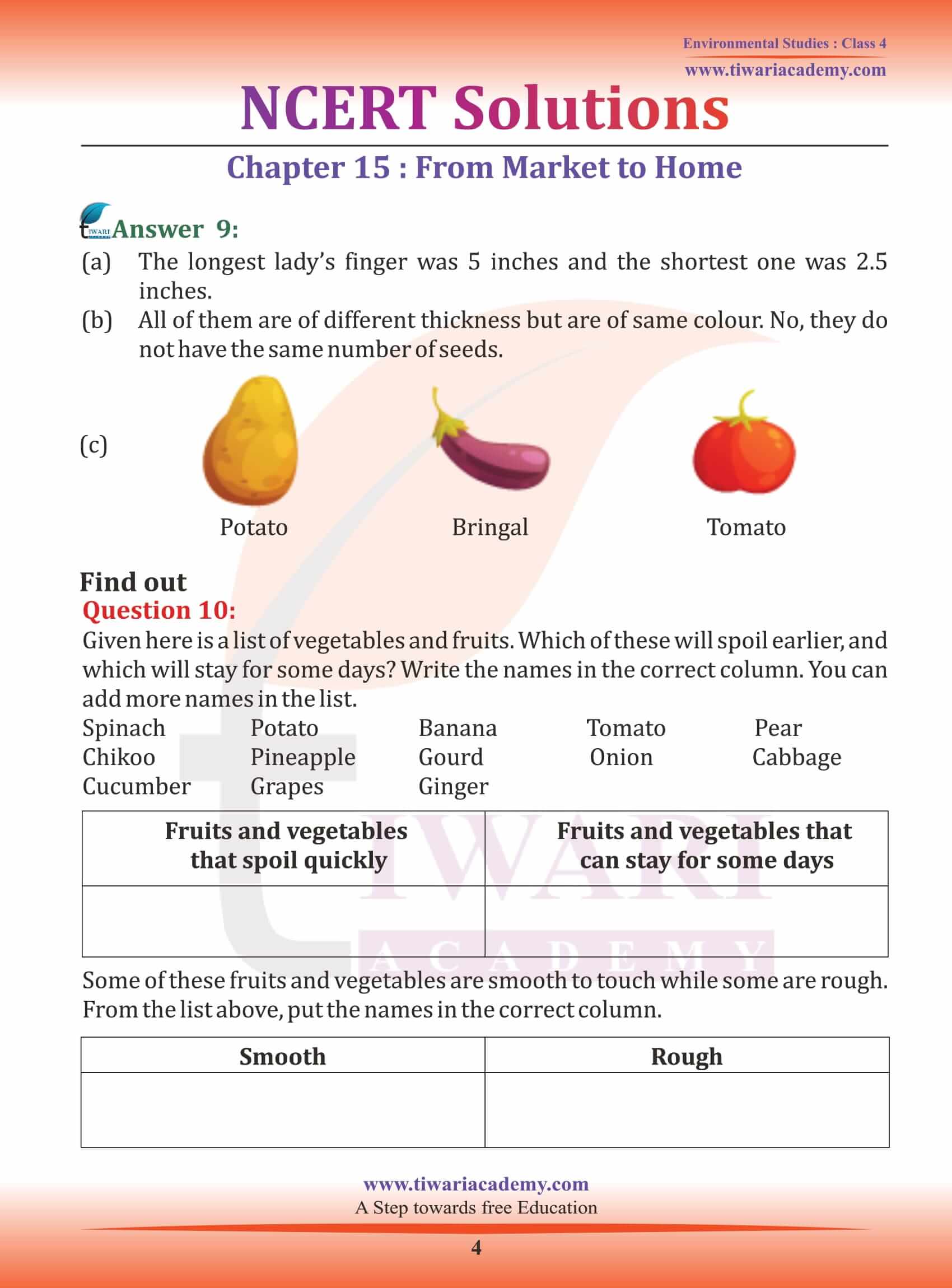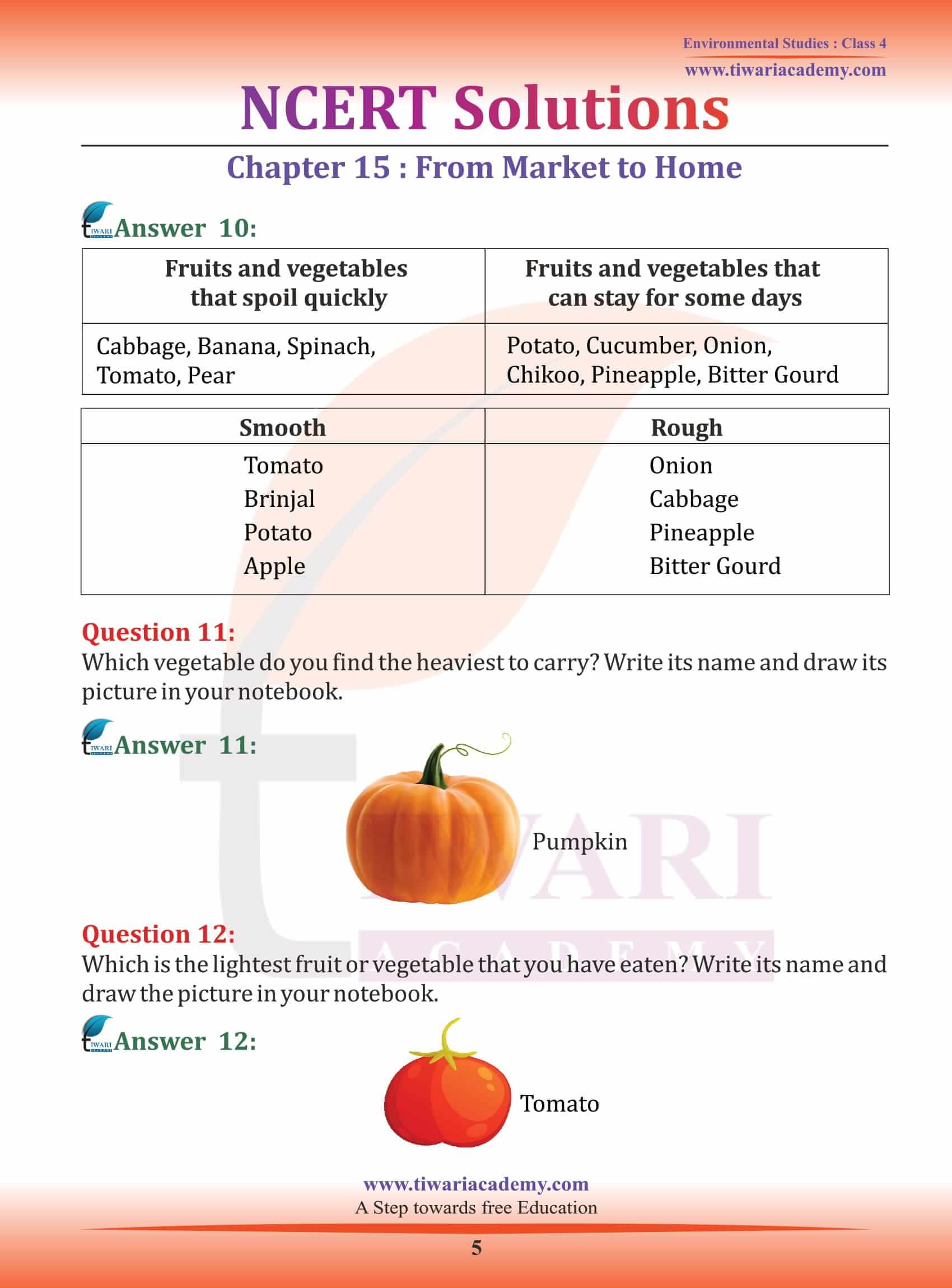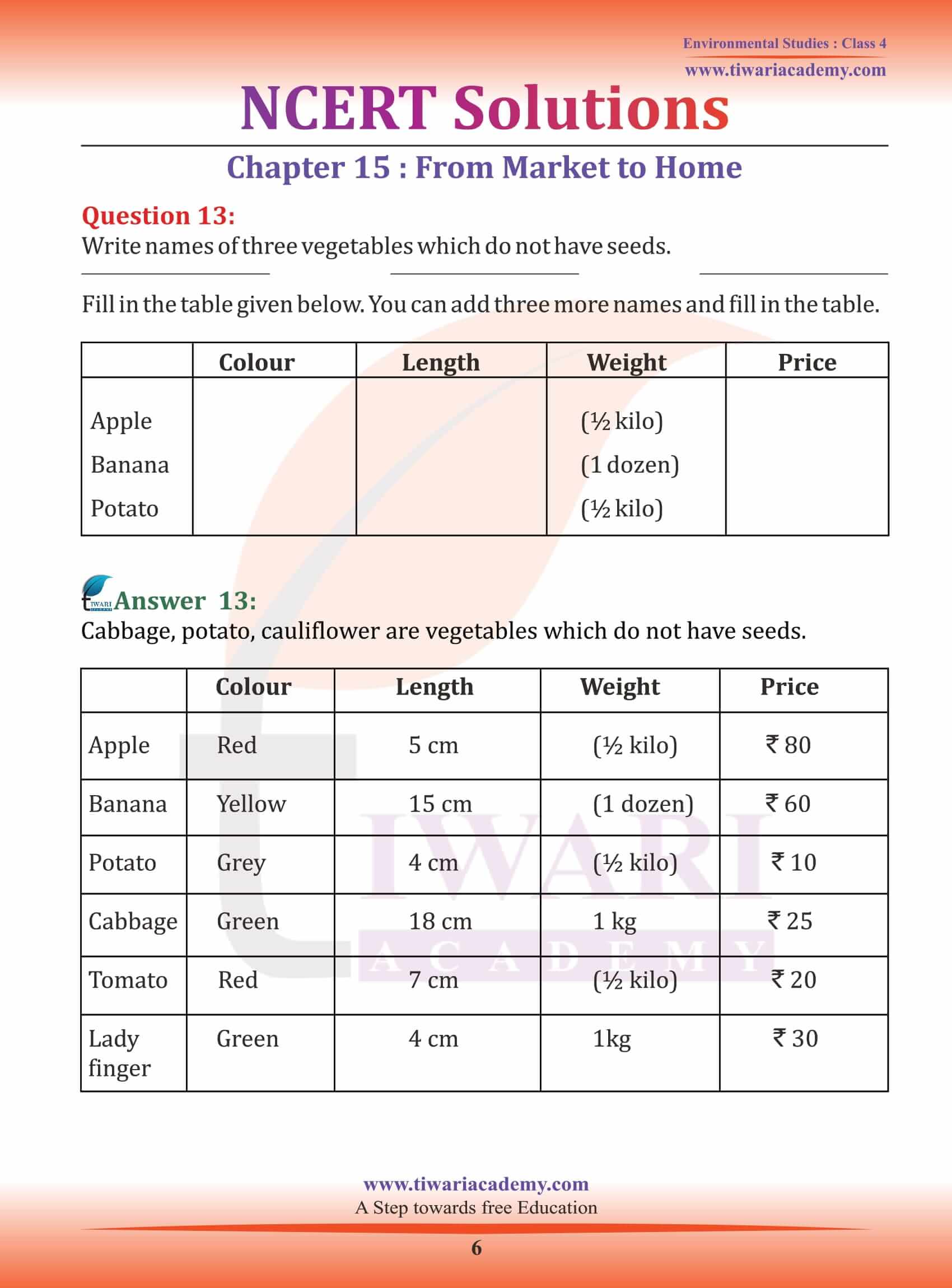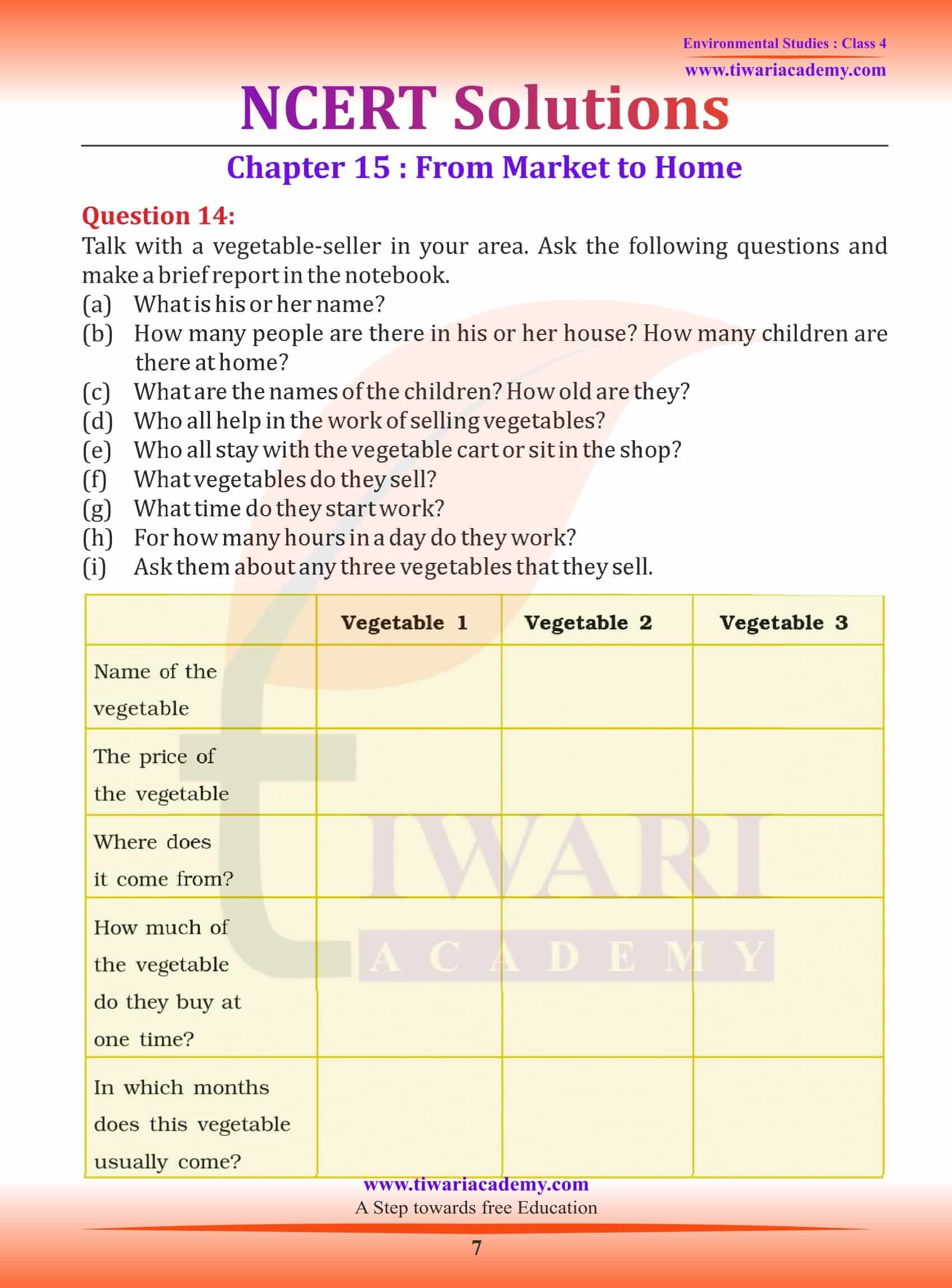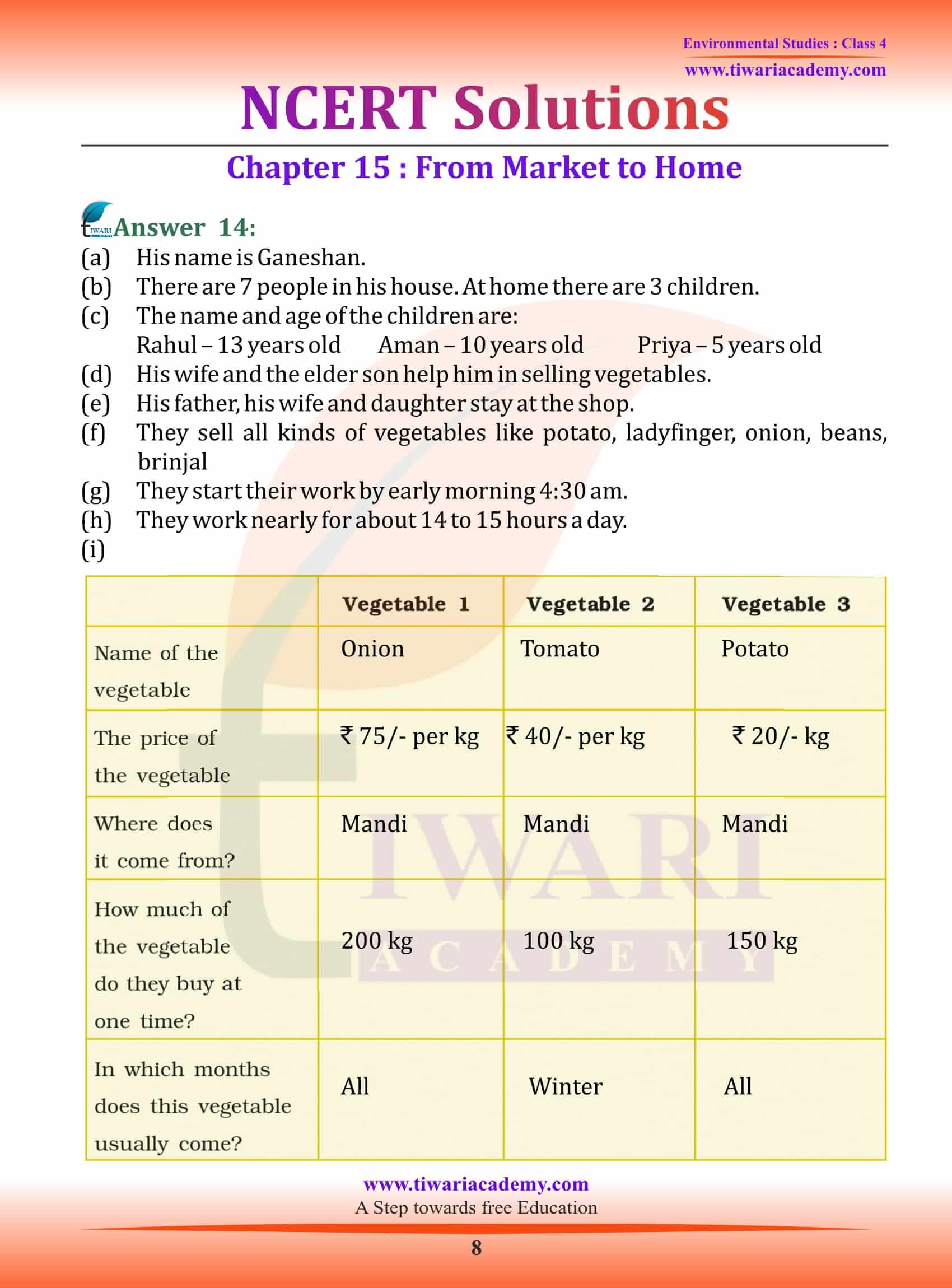NCERT Solutions for Class 4 EVS Chapter 15 From Market to Home in Hindi and English Medium all the question answers given in exercises and in-between the pages including extra important questions. Entire contents are updated according to new CBSE Syllabus 2025-26 free to use online or download in PDF file format. Answers are simplified in such a way that every student can understand easily.
NCERT Solutions for Class 4 EVS Chapter 15
Class 4 EVS Chapter 15 Question Answers with Important Extra Questions
Class 4 EVS Chapter 15 Question Answers Set 1
Does anyone in your house have to get up very early? What time does he or she get up? Why do they need to get up so early?
My mother gets up very early. She gets up at 5.00 AM. She gets up to prepare breakfast for all so that we can go school right time.
Babuji sells the previous day’s vegetables first. Why do you think he does this?
babuji sells previous day vegetables first because they may get spoilt.
Have you seen dried or spoilt vegetables? Where?
Yes, I have seen those in my kitchen and at vegetable shop.
How did you know that the vegetables were spoilt?
A foul smell showed that vegetables were spoiled.
Chhotu is helping his family. What do you think Chhotu has learnt from it?
Chotu would have learnt the value of hard work and money in life. He would also have understood the trick of selling the old vegetables first and then selling the fresh vegetables.
How do you help the elders in your family?
I help my mother in kitchen and in cleaning our home and help my father to bring small household items from shop.
Class 4 EVS Chapter 15 Question Answers Set 2
From where do you get vegetables for your home? Who brings the vegetables?
We get vegetables from nearby market. Both my father and I bring the vegetables.
The next time when you get okra (Bhindi) at home, look at them carefully. Are all of them the same size?
When I bring Bhindi from market they different shape and size.
Find the longest and the shortest one. Measure them.
The longest one was 14cm. long and shortest one was 2cm.
Do all the okra (Bhindi) have the same thickness and colour? Cut two okra (Bhindi) lengthwise. Do both of them have the same number of seeds?
No, all Okra (Bhindi) did not have same thickness and color. When we cut two of them along the length, we find that seeds inside them are not in same quantity.
Which vegetable do you find the heaviest to carry? Write its name.
Pumpkin is the heaviest to carry.
Which is the lightest fruit or vegetable that you have eaten? Write its name.
Grapes are the lightest fruit that I have eaten.
Question:
Given here is a list of vegetables and fruits. Which of these will spoil earlier, and which will stay for some days? Write the names in the correct column. Spinach, Potato, Banana, Tomato, Pear, Chikoo, Pineapple, Gourd, Onion, Cabbage, Cucumber, Grapes, Ginger, Mango.
Answer 12:
| Fruits and vegetables that spoil quickly | Fruits and vegetables that can stay for some days |
|---|---|
| Spinach | Potato |
| Banana | Chikoo |
| Tomato | Pineapple |
| Cabbage | Gourd |
| Pear | Onion |
| Grapes | Cucumber |
| Mango | Ginger |
Class 4 EVS Chapter 15 Question Answers Set 3
Write names of three vegetables which do not have seeds.
Potato, cabbage, cauliflower.
Talk with a vegetable-seller in your area. Ask the following questions and make a brief report in the notebook.
I meet shopkeeper of vegetable shop in my area and ask some questions from him.
What is his or her name?
His name is Rajkumar.
How many people are there in his or her house? How many children are there at home?
There are total 6 members in his family. He has two children.
What are the names of the children? How old are they?
His elder son name is Gopal and daughter name is Kavita. Gopla is 10-year-old and Kavita is 7 years.
Who all help in the work of selling vegetables?
Sometime his son helps him after school or on holiday.
Question:
Some of these fruits and vegetables are smooth to touch while some are rough. From the list above, put the names in the correct column.
Answer:
| smooth to touch | Rough to touch |
|---|---|
| Spinach | Potato |
| Banana | Chikoo |
| Tomato | Pineapple |
| Grapes | Ginger |
Class 4 EVS Chapter 15 Question Answers Set 4
Who all stay with the vegetable cart or sit in the shop?
He, his wife, and elder son.
What vegetables do they sell?
He sells Potato, onion, tomato, cabbage, cauliflower and other vegetables.
What time do they start work?
early in the morning at 5 o’ clock.
For how many hours in a day do they work?
They work approximate 16 to 18 hours daily.
Ask them about any three vegetables that they sell.
The main three vegetables they sell are:
1. Tomato
2. Potato
3. Onion
Question:
What work was Vaishali’s father doing?
Answer:
Vaishali’s father was a vegetable seller.
Class 4 EVS Chapter 15 Extra Question Answers Set 1
What does occupation mean?
An activity or task with which one does to earn money, usually a productive activity, service, trade, or craft for which one is regularly paid.
Who all helped Vaishali’s father in his work?
Vaishali’s whole family, Amma, Bhaiya, Chhotu and Vaishali, helped him with his work.
At what time did they start doing their work?
At 3 o’clock in the morning. When most people are fast asleep, their day’s work used to begin when Babuji, Amma, Bhaiya and Vaishali used to take out the previous day’s vegetables from the gunny bags and baskets. This was done to prepare for bringing the fresh vegetables from the mandi. Sometimes Chhotu also helped them.
What did the family do after that?
As they finished doing their work and are having some tea, they waited for the tempo. When the tempo came, Babuji, Bhaiya, Chachu (uncle) and some others from their street left for the mandi.
Why did they sprinkle water on the previous day’s vegetables?
They sprinkled water on the previous day’s
vegetables so that they could keep them fresh and would not dry up the whole day.
Class 4 EVS Chapter 15 Extra Question Answers Set 2
What do they do after coming back from the mandi?
By 6.30 a.m. Vaishali’s Babuji comes back from the mandi with baskets and sacks full of fresh vegetables. At that time their house looks more like a small vegetable market. There are brinjals, potatoes, tomatoes, okra (Bhindi), pumpkin, gourds, chillies and many other vegetables all around. Everybody sorts the vegetables. The vegetables which are not fully ripe and ready to sell are kept aside. We have to sort the vegetables fast, so as to reach the bazaar as early as possible.
What is the role of vegetable mandi?
The vegetable mandi or markets provide healthier and fresh vegetables and food items than the vegetable and food items that are available in the supermarkets. The vendors directly come and sell in almost every neighborhood. So it is convenient for almost everybody everywhere.
What did Vaishali’s father do with the vegetables?
Vaishali’s father arranged all the vegetables on the handcart and leave for the bazaar. He said that if he would get late, then his regular buyers may buy their vegetables from someone else.
How did Chottu help bapuji?
Chhotu attended the school in the afternoon. He would take rest for a while and go to the bazaar later with food for Babuji and Bhaiya. He stayed with them at the vegetable cart, until it was thetime for him to go to school. Sometimes he would go back after school to help Babuji.
Give reason why we cook some food items before eating them.
Cooking adds flavour and aroma to the food and makes it soft, tasty and easy to digest. It also kills germs and protects us from diseases.
What would happen if we overcook our food?
Overcooking the food is harmful as the nutrients are destroyed and we do not get proper nutrition.
Class 4 EVS Chapter 15 Extra Question Answers Set 3
What are the favourable conditions for the growth of germs in food?
The food kept for a long time gets spoilt by the action of germs that start growing on the eatables when they get water and warmth.
What is food preservation?
The process of treating and handling the food in such a manner that stops or slows down food spoilage and maintain its nutritional value, appearance and flavour, is known as Food Preservation. Food can be stored for a longer time by preventing the growth of germs in it.
What are the different ways of preserving food?
There are several methods to keep food safe and preserve it. For eg: dehydration, salting, freezing, sweetening etc.
Explain the various methods of food preservation.
The various methods of food preservation are-
• SALTING: We can add salt to the food items to preserve them. Example: pickles, fish, etc.
• BOILING: It can prevent food spoilage for a short time and kills germs present in the food items. Example: milk
• REFRIGERATION AND FREEZING: Germs do not grow easily in cool places so food kept in refrigerator remains fresh for some days. Example: fruits, vegetables, milk, cooked food etc
• SWEETENING: Excess sugar in the food especially fruits, also acts as a preservative and helps us store food for a long time. Example: jams, jellies, squashes, murabba etc.
• DEHYDRATION: Water is removed from the food items by drying them under the sun, to stop the growth of germs in them. Example: red chillies, raw mangoes, chips, dry fruits, etc.
Question:
What is food spoilage?
Answer:
Food spoilage is a process where a food product becomes unfit and unsuitable to be consumed by us. The food kept for a long time gets spoil by the action of germs that start growing on the eatables when they get water and warmth. The food colour, taste and smell changes due to the growth of germs and we may fall ill if we eat such food.
What is the story of Vaishali in unit 15 of class 4th EVS tells us about?
The story of Vaishali has given us the knowledge of how organically grown vegetables are being delivered to our homes. The important people who are working hard while most of the world is sleeping to get us delivered the fresh vegetables. We have already studied how the vegetables are grown and this chapter informed how these vegetables reached our kitchens.
Do you think these people in chapter 15 of class 4th EVS are also playing an important role in preserving nature?
Food wastage is the major problem in the world and there are certain major steps are being taken like delivering the food to the homes and kitchen as soon as possible so that wastage during the transportation can be reduced.
Do you think the effective way of understanding food availability is given in chapter 15 of class 4 EVS?
I think the chapter gives us the basic knowledge of how the routine of a vegetable seller is. Not clear how the vegetables are transported but it is informed in the chapter the sellers took the vegetable to Mandi (Market) to sell them which is part of the small market. For far-away reaching areas, there are different types of transportation methods used which part is still not here. Otherwise, this would have made this chapter lengthier. However, the best way to understand the work of food sellers is to read the chapter.
When would you suggest one should do this chapter 15 of 4 standard EVS for the exams?
The chapter is fairly easy to cover and understand to so it is completely up to the reader’s discretion to complete the chapter as their schedule because for sure this chapter is not going to take much time. So one can complete this chapter anytime.
